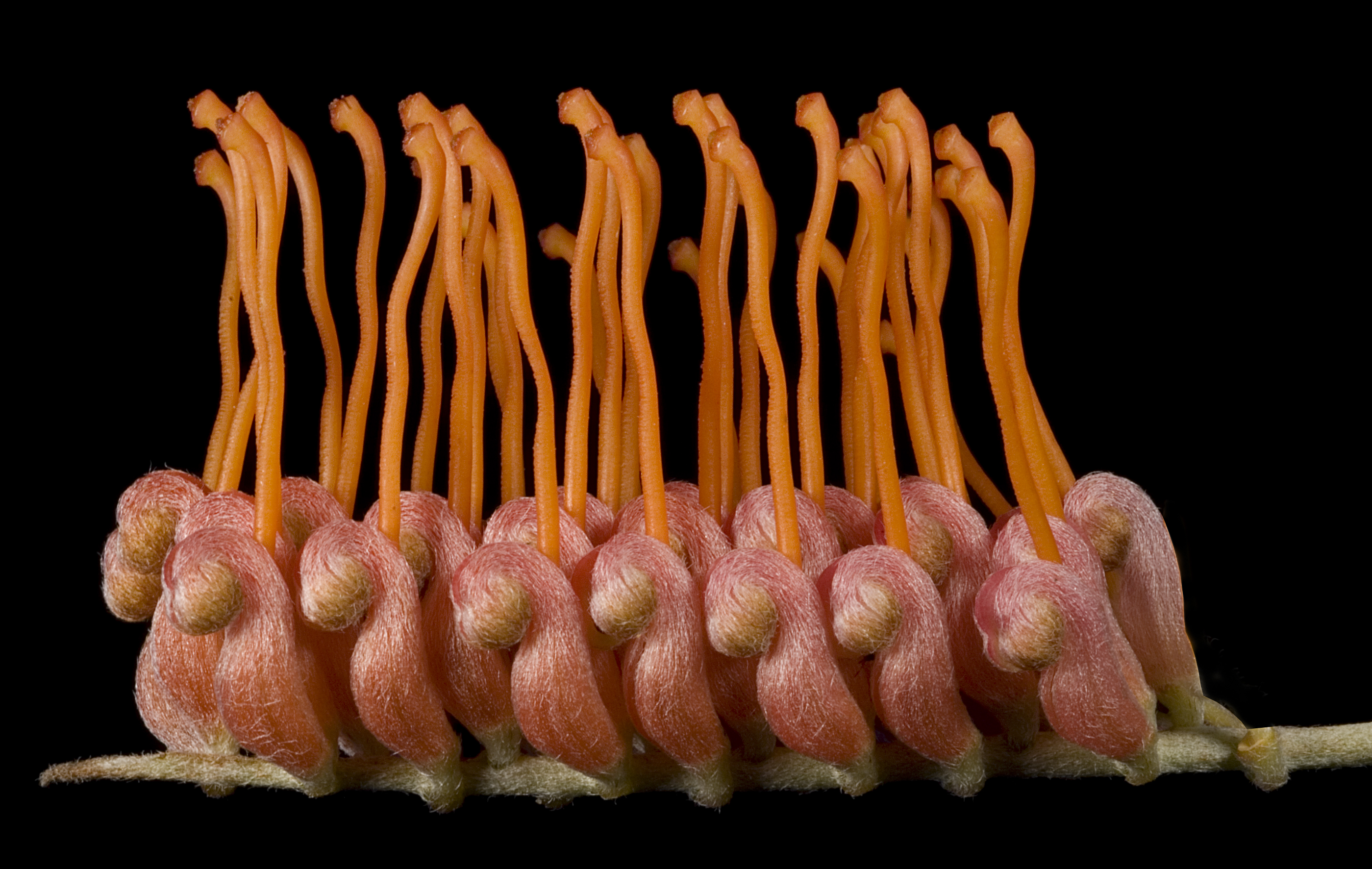|
Grevillea Cagiana
''Grevillea cagiana'', commonly known as red toothbrushes, is a species of flowering plant in the family Proteaceae and is endemic to the south-west of Western Australia. It is an erect or spreading shrub with Leaf#Divisions_of_the_blade, simple or divided leaves with linear lobes, and green, yellow, orange or pink flowers with red Style (botany), styles. Description ''Grevillea cagiana'' is an erect or spreading shrub that typically grows to a height of . Its leaves are long and simple or divided with up to eleven erect, linear lobes long and wide with the edges rolled under, obscuring the lower surface. The flowers are arranged in toothbrush-like groups, the rachis long, the flowers green, yellow, orange or pink, the Gynoecium#Pistils, pistil mostly long and the Style (botany), style bright orange-red to red. Flowering occurs from June to March and the fruit is a silky-hairy Follicle (fruit), follicle long. Taxonomy ''Grevillea cagiana'' was first formally described in 1 ... [...More Info...] [...Related Items...] OR: [Wikipedia] [Google] [Baidu] |
Charles Austin Gardner
Charles Austin Gardner (6 January 1896 – 24 February 1970) was an English-born Western Australian botanist. Biography Born in Lancaster, in England, on 6 January 1896, Gardner emigrated to Western Australia with his family in 1909, where they took possession of land at Yorkrakine. Gardner showed an interest in art and botany from youth, becoming engrossed in his state museum's copy of Bentham's ''Flora Australiensis'' (London, 1863-78) and received encouragement from the government's botanist Desmond Herbert and botanical artist Emily Pelloe. After a BSc in Biology, he was appointed a botanical collector for the Forests Department in 1920, and the following year was engaged as botanist on the Kimberley Exploration Expedition, resulting in his first publication, ''Botanical Notes, Kimberley Division of Western Australia'', which gave descriptions for twenty new species. In 1924 he transferred to the Department of Agriculture, and following a departmental re-organisa ... [...More Info...] [...Related Items...] OR: [Wikipedia] [Google] [Baidu] |
Flora Of Western Australia
The flora of Western Australia comprises 10,551 published native vascular plant species and a further 1,131 unpublished species. They occur within 1,543 genera from 211 families; there are also 1,317 naturalised alien or invasive plant species more commonly known as weeds. There are an estimated 150,000 cryptogam species or nonvascular plants which include lichens, and fungi although only 1,786 species have been published, with 948 algae and 672 lichen the majority. History Indigenous Australians have a long history with the flora of Western Australia. They have for over 50,000 years obtained detailed information on most plants. The information includes its uses as sources for food, shelter, tools and medicine. As Indigenous Australians passed the knowledge along orally or by example, most of this information has been lost, along many of the names they gave the flora. It was not until Europeans started to explore Western Australia that systematic written details of the flora comme ... [...More Info...] [...Related Items...] OR: [Wikipedia] [Google] [Baidu] |
Proteales Of Australia
Proteales is an order of flowering plants consisting of three (or four) families. The Proteales have been recognized by almost all taxonomists. The representatives of the Proteales are very different from each other. The order contains plants that do not look alike at all. What they have in common is seeds with little or no endosperm. The ovules are often atropic. Families In the classification system of Dahlgren the Proteales were in the superorder Proteiflorae (also called Proteanae). The APG II system of 2003 also recognizes this order, and places it in the clade eudicots with this circumscription: * order Proteales :* family Nelumbonaceae :* family Proteaceae family Platanaceae">Platanaceae.html" ;"title=" family Platanaceae"> family Platanaceae with "+ ..." = optionally separate family (that may be split off from the preceding family). The APG III system of 2009 followed this same approach, but favored the narrower circumscription of the three families, firmly reco ... [...More Info...] [...Related Items...] OR: [Wikipedia] [Google] [Baidu] |
Grevillea
''Grevillea'', commonly known as spider flowers, is a genus of about 360 species of evergreen flowering plants in the family Proteaceae. Plants in the genus ''Grevillea'' are shrubs, rarely trees, with the leaves arranged alternately along the branches, the flowers zygomorphic, arranged in racemes at the ends of branchlets, and the fruit a follicle that splits down one side only, releasing one or two seeds. Description Plants in the genus ''Grevillea'' are shrubs, rarely small trees with simple or compound leaves arranged alternately along the branchlets. The flowers are zygomorphic and typically arranged in pairs along a sometimes branched raceme at the ends of branchlets. The flowers are bisexual, usually with four tepals in a single whorl. There are four stamens and the gynoecium has a single carpel. The fruit is a thin-walled follicle that splits down only one side, releasing one or two seeds before the next growing season. Taxonomy The genus ''Grevillea'' was first forma ... [...More Info...] [...Related Items...] OR: [Wikipedia] [Google] [Baidu] |
Department Of Biodiversity, Conservation And Attractions (Western Australia)
The Department of Biodiversity, Conservation and Attractions (DBCA) is the Government of Western Australia, Western Australian government department responsible for managing lands and waters described in the ''Conservation and Land Management Act 1984'', the ''Rottnest Island Authority Act 1987'', the ''Swan and Canning Rivers Management Act 2006'', the ''Botanic Gardens and Parks Authority Act 1998'', and the ''Zoological Parks Authority Act 2001'', and implementing the state's conservation and environment legislation and regulations. The Department reports to the Minister for Environment and the Minister for Tourism. DBCA was formed on 1 July 2017 by the merger of the Department of Parks and Wildlife (Western Australia), Department of Parks and Wildlife (DPaW), the Botanic Gardens and Parks Authority, the Zoological Parks Authority and the Rottnest Island Authority. The former DPaW became the Parks and Wildlife Service. Status Parks and Wildlife Service The Formerly the Depar ... [...More Info...] [...Related Items...] OR: [Wikipedia] [Google] [Baidu] |


